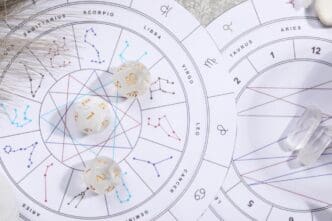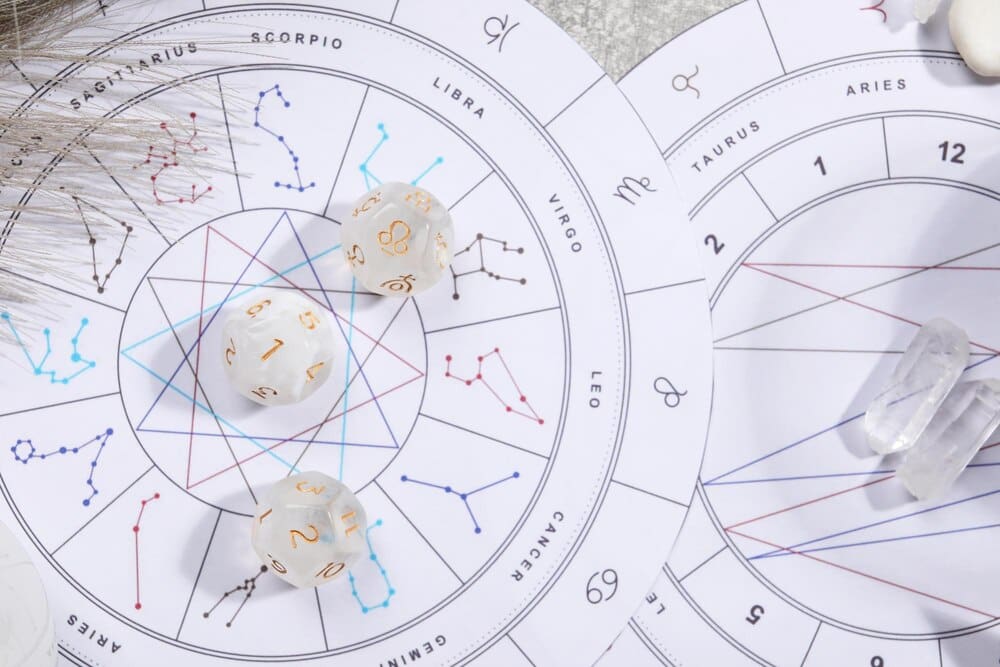A birth chart, known in astrological circles as a natal chart, is the single most important tool for self-discovery within astrology. It is a highly personalized map of the heavens, capturing the exact positions of the planets and stars at the precise moment of an individual’s birth, from the specific vantage point of their birthplace. This celestial snapshot serves as a cosmic blueprint, offering profound and detailed insights into a person’s core personality, emotional needs, innate strengths, potential challenges, and overarching life purpose. Far more than just a Sun sign, the natal chart is a complex and unique guide that helps answer the fundamental question: “Who am I?”
What Exactly is a Birth Chart?
Imagine freezing time at the moment you took your first breath. A birth chart is a two-dimensional representation of that three-dimensional celestial moment. It is depicted as a 360-degree wheel, divided into twelve segments, which contains a collection of symbols representing planets, signs, and geometric relationships.
To generate an accurate chart, three pieces of information are absolutely essential: your date of birth, your city of birth, and, most critically, your exact time of birth. While the date determines the position of the Sun (your Sun sign), the time of birth determines the entire structure of the chart, including your Ascendant (Rising Sign) and the placement of the planets within the twelve houses.
Without an accurate birth time, down to the minute if possible, key components of the chart can shift, altering the interpretation significantly. It is the difference between having a general map of a country versus a detailed GPS route to a specific address.
The Three Pillars of Your Chart: Sun, Moon, and Rising
While every part of the chart is significant, astrologers always begin an interpretation with the “big three”: your Sun sign, Moon sign, and Rising sign. These three placements form the foundational triad of your personality, describing your core identity, your inner emotional world, and your social persona.
The Sun Sign: Your Core Identity
The Sun represents your ego, your fundamental character, your life force, and your conscious self. It is the “I am” of the zodiac and governs your primary drive and the overall themes of your life’s journey. When people ask, “What’s your sign?” they are referring to your Sun sign.
Your Sun sign describes the qualities you are here to develop and express. It is your heroic path, the energy you shine out into the world. For example, a person with their Sun in Leo is learning to express themselves creatively and lead from the heart, while a person with their Sun in Virgo is on a path of service, analysis, and practical improvement.
The Moon Sign: Your Inner World
If the Sun is your conscious self, the Moon is your subconscious and emotional core. It represents your feelings, instincts, intuition, and what you need to feel safe, nurtured, and secure. It is the “I feel” of the zodiac and governs your private self, the person you are when no one is watching.
Your Moon sign reveals your immediate emotional reactions and your ingrained habits. Understanding your Moon sign is key to understanding your emotional needs in relationships. A Moon in Cancer craves emotional security and a sense of family, while a Moon in Aquarius needs emotional freedom and intellectual connection.
The Rising Sign (Ascendant): Your Social Mask
The Rising sign, or Ascendant, is the zodiac sign that was ascending on the eastern horizon at the exact time of your birth. It represents your social “mask,” the way you present yourself to the world, and the first impression you make on others. It also dictates how you begin new things and your general approach to life.
Crucially, the Ascendant marks the beginning of the first house of your natal chart, setting up the entire house system. It is the lens through which you view the world and through which the world views you. Someone with a Scorpio Rising may appear intense, private, and powerful, even if their Sun sign is a more lighthearted Gemini.
The Planets: The Actors on Your Stage
The planets are the active energies in your chart. Each celestial body represents a different psychological function or drive—they are the “actors” in the play of your life. They are categorized into personal, social, and generational planets based on the speed of their orbits.
The Personal Planets
These planets move quickly and have a direct impact on your day-to-day personality and immediate concerns.
- Mercury: The planet of communication, intellect, and logic. It governs how you think, learn, and express your ideas.
- Venus: The planet of love, beauty, values, and finances. It reveals what you find attractive, your style in relationships, and your relationship with money.
- Mars: The planet of action, desire, and aggression. It dictates your drive, your ambition, how you assert yourself, and your physical energy.
The Social Planets
Jupiter and Saturn bridge the personal and the collective, describing your relationship with society and its structures.
- Jupiter: The planet of expansion, luck, wisdom, and abundance. It shows where you are likely to find growth, opportunity, and fortune.
- Saturn: The planet of structure, discipline, responsibility, and limitation. It points to your greatest life lessons, where you must work hard, and where you can build lasting mastery.
The Generational (Outer) Planets
These planets move very slowly, spending many years in a single sign. Their placement affects entire generations, shaping broad societal trends and transformations.
- Uranus: The planet of innovation, rebellion, and sudden change. It highlights where you are unconventional and seek freedom.
- Neptune: The planet of dreams, spirituality, and illusion. It reveals your connection to the mystical, your creative inspiration, and where you may be prone to confusion.
- Pluto: The planet of power, transformation, and rebirth. It points to the deepest, most subconscious parts of your psyche and where you will undergo profound change.
The Zodiac Signs: The Costumes They Wear
If the planets are the actors, the twelve zodiac signs are the “costumes” they wear or the “roles” they play. A sign describes *how* a planet’s energy is expressed. The fiery, impulsive nature of Aries is vastly different from the grounded, deliberate nature of Taurus.
For example, Mercury (communication) in the sign of Gemini (curious, witty) will express itself very differently than Mercury in Pisces (intuitive, non-linear). The first is a fast-talking debater, while the second is a poetic storyteller. The sign flavors the function of the planet.
The Houses: The Stages of Life
The twelve houses of the birth chart are the “stages” or areas of life where the planetary energies play out. Each house governs a specific domain of human experience, from career and relationships to home and spirituality. The sign on the cusp (or beginning) of each house, along with any planets located within it, reveals your orientation to that area of life.
- 1st House: Self, identity, appearance, new beginnings.
- 2nd House: Money, possessions, values, self-worth.
- 3rd House: Communication, siblings, local community, short trips.
- 4th House: Home, family, roots, emotional foundations.
- 5th House: Creativity, romance, pleasure, children, self-expression.
- 6th House: Daily work, health, routines, service to others.
- 7th House: Committed partnerships, marriage, contracts, open enemies.
- 8th House: Shared resources, intimacy, death, taxes, transformation.
- 9th House: Higher learning, long-distance travel, philosophy, belief.
- 10th House: Career, public reputation, legacy, authority.
- 11th House: Friendships, groups, community, hopes for the future.
- 12th House: The subconscious, secrets, spirituality, endings, karma.
Having Venus (love) in the 7th House (partnerships) places a strong emphasis on one-on-one relationships. In contrast, Venus in the 11th House (friendships) might find love within their social circle or value platonic connections more highly.
The Aspects: The Dialogue Between Actors
Aspects are the geometric angles between planets in the chart. They are critically important because they describe how the different planetary energies interact with one another—whether they cooperate harmoniously, challenge each other, or blend their functions.
Major Aspects
- Conjunction (0°): A powerful fusion of two planetary energies. They act as one, for better or worse.
- Sextile (60°): An aspect of opportunity and easy communication. The planets support each other.
- Square (90°): An aspect of tension and challenge. It creates internal friction that pushes you to take action and grow.
- Trine (120°): An aspect of natural talent and harmony. The energies flow together effortlessly, indicating an innate gift.
- Opposition (180°): An aspect of polarity and awareness. It creates a push-pull dynamic that requires balance and integration.
While “soft” aspects like trines and sextiles feel easy, it is often the “hard” aspects like squares and oppositions that become our greatest catalysts for achievement and self-awareness. They represent the grit in the oyster that creates the pearl.
How to Get Your Birth Chart
Generating your personal birth chart is easier than ever. Numerous reputable websites, such as Astro.com or CafeAstrology.com, offer free chart calculation services. You will simply need to enter your full birth date, your city and country of birth, and your exact birth time as listed on your birth certificate.
If you do not know your birth time, you can still run a “Solar Chart,” which places your Sun on the Ascendant. While this provides some insight, it lacks the specific accuracy of a timed chart, especially regarding the houses. For a more precise but unknown time, consulting a professional astrologer for a service known as “chart rectification” is an option.
Ultimately, your birth chart is not a rigid script that dictates your fate, but rather a dynamic and living map of your potential. It is a profound tool for self-compassion and understanding, illuminating your natural gifts and highlighting the areas ripe for growth. Approaching your chart with curiosity empowers you to navigate your life with greater awareness, align more closely with your purpose, and appreciate the unique cosmic signature that is entirely your own.








